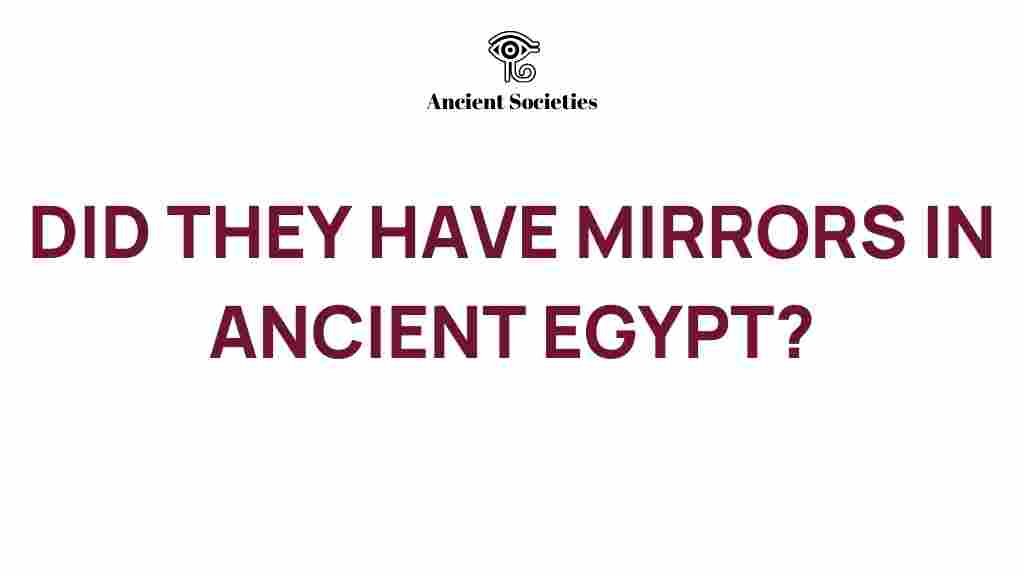Reflecting on the Past: Did Ancient Egyptians Use Mirrors?
The allure of ancient Egypt captivates many, from its monumental pyramids to its intricate hieroglyphs, but one aspect of daily life often overlooked is the use of mirrors. Mirrors, as artifacts, provide a fascinating glimpse into the culture, technology, and daily life of the ancient Egyptians. In this article, we’ll explore the history of mirrors in ancient Egypt, their significance in society, and the archaeological findings that shed light on this topic.
The History of Mirrors in Ancient Egypt
The use of mirrors dates back thousands of years, and ancient Egypt stands as one of the earliest civilizations to utilize reflective surfaces. The earliest mirrors were not made of glass as we know them today but were crafted from highly polished metals such as bronze and copper. These materials were favored for their reflective qualities, enabling ancient Egyptians to see their reflections, albeit in a less clear way than modern mirrors.
Types of Mirrors Used in Ancient Egypt
Archaeological findings reveal that the ancient Egyptians employed various types of mirrors:
- Metal Mirrors: The most common form of mirrors in ancient Egypt, made from polished bronze or copper.
- Stone Mirrors: Some mirrors were crafted from polished stones like obsidian, which, while not as common, were prized for their reflective properties.
- Glass Mirrors: Although rare, glass mirrors appeared later in ancient Egyptian history, typically in the Greco-Roman period.
Significance of Mirrors in Ancient Egyptian Culture
Mirrors held more than just a practical use; they were imbued with cultural significance. Here’s how mirrors fit into the broader context of ancient Egyptian life:
- Beauty and Grooming: Mirrors were essential for personal grooming. Ancient Egyptians placed a high value on beauty, and mirrors allowed individuals to apply cosmetics and groom themselves effectively.
- Spiritual Symbolism: Mirrors were often associated with the goddess Hathor, who represented beauty, love, and motherhood. They were believed to reflect not just physical appearance but also one’s inner beauty and soul.
- Funerary Practices: In tombs, mirrors were often included among the grave goods. They were thought to help the deceased in the afterlife by providing a means to reflect on their earthly existence.
Archaeological Discoveries of Mirrors
Archaeology has unearthed numerous artifacts that confirm the existence and use of mirrors in ancient Egypt. Some notable discoveries include:
- The Tomb of Tutankhamun: Among the many treasures found in the tomb of the young pharaoh, several metal mirrors were discovered, showcasing their significance in royal burial customs.
- Artifacts from Saqqara: Excavations in Saqqara have revealed polished stone mirrors, which highlight the craftsmanship and technological advancements of the time.
- Household Items: Many mirrors were found in domestic settings, indicating their importance in daily life for all social classes, not just the elite.
The Technology Behind Ancient Mirrors
The technology of making mirrors in ancient Egypt was relatively advanced for its time. The process typically involved:
- Material Selection: Choosing suitable metals or stones that could be polished to achieve a reflective surface.
- Polishing Techniques: Using abrasives to smooth the surface of the metal or stone until it was highly reflective. This required skill and knowledge of materials.
- Finishing Touches: Often, mirrors were adorned with handles or decorative elements, making them not just functional but also artistic.
Daily Life and Mirrors in Ancient Egypt
Mirrors played a crucial role in the daily lives of ancient Egyptians. Their presence was felt in various aspects:
- Cosmetics: Both men and women used mirrors for the application of eye makeup and other cosmetic practices, reflecting the cultural importance of appearance.
- Social Interactions: Mirrors were often used in social settings, where individuals would check their appearances before entering gatherings or ceremonies.
- Rituals and Ceremonies: In religious practices, mirrors may have been used to reflect light, which was symbolically important in rituals dedicated to various deities.
Challenges and Misconceptions
Despite the evidence of mirrors in ancient Egypt, several misconceptions persist:
- Exclusivity: Some believe that only the wealthy used mirrors, but archaeological evidence shows they were common household items.
- Material Limitations: While early mirrors were primarily made of metal and stone, the later developments in glass mirrors were also significant, although they appeared later in history.
Conclusion: The Reflection of Culture in Mirrors
Mirrors in ancient Egypt are more than mere artifacts; they reflect the values, technology, and daily life of a civilization that continues to fascinate us today. From their functional use in beauty and grooming to their spiritual significance and role in funerary practices, mirrors offer a unique window into the culture and history of ancient Egypt.
As archaeologists continue to uncover new artifacts, our understanding of ancient Egyptian life, including the use of mirrors, deepens. These reflective surfaces not only served practical purposes but also acted as symbols of beauty and self-reflection in a society rich with traditions and beliefs.
To explore more about ancient Egyptian artifacts and their significance, you can visit this resource. For a deeper dive into the archaeological techniques used to discover these treasures, check out this link.
This article is in the category Archaeology and created by AncientSocieties Team
